In a wooden, built of timber or log house, an amazing atmosphere is always created, which has a beneficial effect on the psychological and physical state of tenants, and this is due to the properties of natural wood. So that in such a dwelling it was warm, and it was not blocked with strong wind and did not warm up in the winter period, its walls need to be well insulated by choosing the corresponding material for this process.
Interwette insulation for timber What to choose to achieve all goals to achieve? This question arises from everyone who started the construction of a church for the house. Since the breveled buildings were built before the time of centuries, only natural materials were always used for the insulation of such walls. This tradition has passed these days, although today there is a considerable amount of artificial insulators - they could not fully replace those natural, which were traditionally used by the builders.
If the construction of a church is entrusted to a construction team, then it will be useless to keep the entire work process under control and independently choose and acquire all the necessary auxiliary materials, including the interventic insulation. Otherwise, it can be obtained as a result of a poor-quality work, which is sometimes simply not possible to correct without the total bulkhead of the entire cut.
For what purposes is the interventical insulation applied?
To understand how important it is to choose the right and high-quality insulation, you need to fully represent, for which it is needed when building a wooden log cabin.
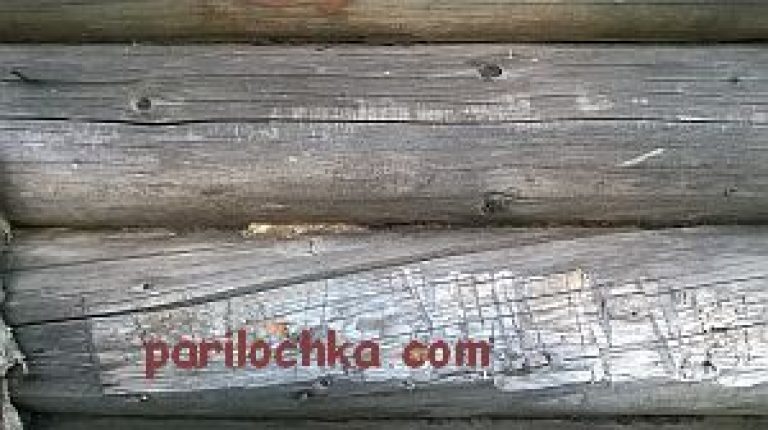
Interwetant insulation is needed:
- To preserve and strengthen all the thermal insulation qualities of Dr Evice, as well as to maximize the extension of the construction period.
- To avoid penetration between logs or moisture bar, with the subsequent emergence and development of foci of mold or fungus, nests unwanted in the house of insects.
- To provide paropropustea Abilities, as wood is breathable and reacts to increased humidity and temperature differences. Therefore, the interventic insulation is mounted not only between the bar or logs, but also around the window frames and door boxes.
If there is a properly selected and laid insulation, the residential structure acquires the necessary quality for it:
- low thermal conductivity, as the walls will not have cold bridges;
- resistance to a strong wind, because the walls become not blown;
- Balance equilibrium moisture-absorption and evaporation moisture.
As can be seen, this one would seem at first glance, a minor element has a serious impact on the quality, and the overall durability of the construction.
What is the insulation for the crowns to choose?
Previously, the construction of materials produced at home from various plants was used to build wooden logs for insulation. The main of them was flax, the fibers of which is a good "breathable" heat insulator. As is known, fabric was made of flax, and unsuitable rough parts of the plant turned into a heater for the walls of the house.
In addition to flax, a moss was used to seal the jacks of logs, which in large quantities could be found in the forest more often and on the swamps.
Another popular insulation, used to close the gaps between the logs, is felt, which was made from sheep wool, sprinkling it, and then cutting into the strips of the desired width and thickness.
These materials are perfectly harmonized with wood, so the hut insulated by them served without additional repair for many decades.
Today in specialized stores you can find many different artificially produced materials, which manufacturers offer instead of traditional. They have more low priceThan natural insulation, so many inexperienced owners in construction business acquire them, not knowing about the consequences of such an application. Such materials include polystyrene foam, mineral wool, silicone sealants or foam. Modern artificial insulation, of course, have their advantages, and in some cases without them just do not do, but they are categorically not suitable for laying between the crowns between the crowns.
Video: A brief overview of interwetant insulation
Natural interventic insulation
Linovatin for the insulation of the crowns

As can be understood from the title of the insulation, it is made of flax, it is often called linen felt. It remains popular today, as it meets everything necessary for interventory insulation requirements:
- This is an environmentally pure natural material, so it does not cause allergies even in people with predisposition to it.
- Linovatin today is made not from flax waste, but from purified raw materials, therefore, due to its constituent, the insulation is able to create a microclimate, favorable for the health of tenants.
- Such a heater provides uniform seal over the entire width and length of the crown.
- He perfectly delays wind streams.
- Fleeting does not attract dust and does not rapt himself.
- The material is able to adequately react to fluctuations in humidity - it accumulates, it gives an excessive moisture, supporting the most optimal balance.
- Flap stretch is "breathing, vapor permeable material.
- It provides a high level of thermal insulation and sound insulation, thanks to a good fit to the wood.
- This insulation is very convenient in the installation.

Linovatin is a nonwoven material made by the press and sliced \u200b\u200bon the strip of a certain width, which can vary from 8.5 to 200 mm. The thickness of the material is 5 ÷ 7 mm, the length of the strip in the roll is usually 2000 mm.
If the insulation does not have the desired density, it is placed in two or three layers, fixing on the wedge of a log brackets.

The edges of the insulation should not go beyond the crown, otherwise, after mounting the logs, they will have to score. It is recommended to think over this moment in advance and gently adjust and fasten the edges inside when laying the next crown.
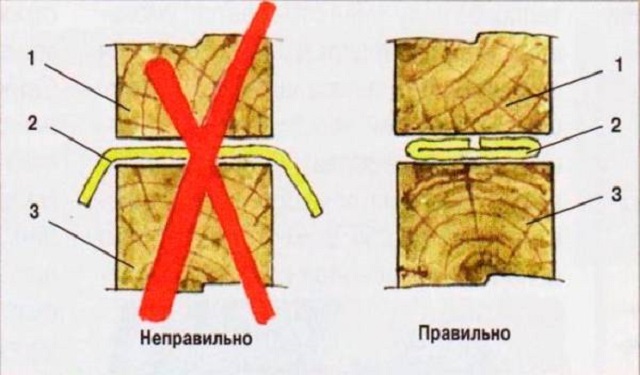
It is necessary to know that, using the flanutin, the joints of the logs after their installation it is recommended to close the decorative cord from the jute so that the seams look aesthetically, and this will result in additional costs.
Linovatin and negative sides:
- It can become a seating from various insects, such as mole, wooden grillers, bugs and others;
- This material is happy to use birds to build the nests, pulling out its pieces of gaps between the logs, which leads to a mandatory repair, in which the seams need to score with the insulation.
Therefore, using the flanutin, it is necessary very well in front of its flooring to cover the antiseptic of bars or logs.
Moss, like an interventic insulation
Such a heater like moss is used for styling between the crowns of Icestari. They did not refuse its application today, as it is still considered the most reliable and affordable material.
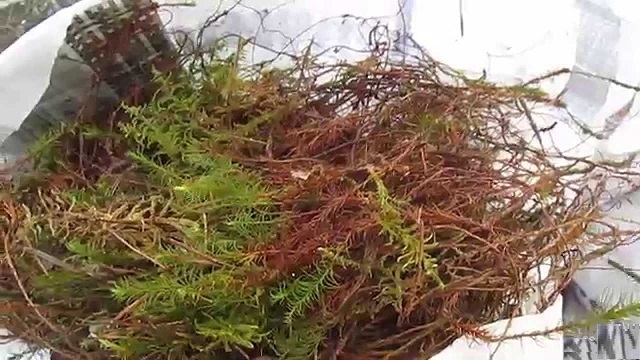
In the regions where there were traditional buildings from logs, almost everywhere grew moss, so it was a non-alternative insulation material for the interventic seal. Warmed by moss at home without repairs served for decades, and even when they were dismantling after many years of operation, it was possible to notice that the logs were preserved in perfect condition and were suitable for the construction of a cut in another place.
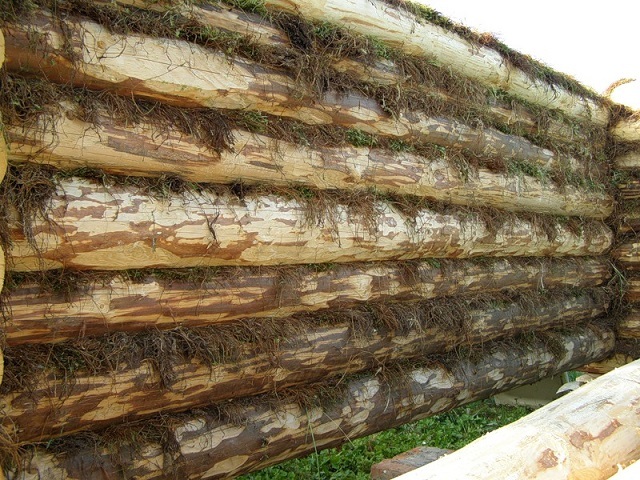
There are about 300 total different species MHA, but for the insulation of wooden log cabins, only two of them are suitable, which are called "SFAGNUM" and "Cukushkin Len". As part of these representatives, the flora contains a large amount of antiseptic substances that are well opposed to putrid processes. Penetrating inside the wood, flavonoids disinfect her fibers, thereby not giving them to decompose.
The log house collected on moss has an amazing fragrance of the forest, so that a special microclimate is created in it. Since the material is environmentally friendly and not allergen, it is safe for a person. In addition, many people suffering from asthma, lung diseases, dermatitis and other ailments, being in such a house, feel significant relief.
Moss is particularly well suited for insulation of walls from logs processed by hand, as they do not have the ideal evenness of the crowns. Moss can be laid in this case unevenly - in some places thicker layer, in others it is quite subtle, which is difficult to do using the belt material.
- Safagnum moss is a low plant with soft small light green leaves and long urine roots. This kind of moss has more antiseptic componentsthan Cukushkin Flax, so the herbalists used it to treat non-healing wounds, as it works on a par with all the famous greenflaw or iodine.

Optimal selection for insulation - Safagn moss
As a heater, this kind of moss is characterized by high density and elasticity. It perfectly supports the balance of foliating wood and does not respond to changes in temperature. In addition, the sphagnum is not afraid of ultraviolet radiation, does not dry out of them and does not lose all its heat insulating properties.
Grows sphagnum in wet swampy terrain or forest more often. It covers the soil with a soft carpet, and it is simple enough to collect it, but it is recommended to conduct this event in sunny dry weather. After collecting, moss is small beams in a sap for short drying. The breakdown time takes one ÷ two weeks, depending on the humidity of the raw material, and it, in turn, will depend on the place and time of plant collection.
Laying the sphagnum on the crowns is quite complex and not as convenient, as when using ready-made ribbons, druses of insulation. But this approach is most effective for thermal insulation and cutting a cut from various negative natural impacts.
- Cuccushkin flashes - hard long fibustal moss of drilling colors. When drying, he acquires a reddish hue. You can find this plant as well as any moss - on a wet swampy terrain or more often. If Cukushkin Flax is going to use as a heater, then it is better to look for it in the forest, as it is not so much written in moisture.
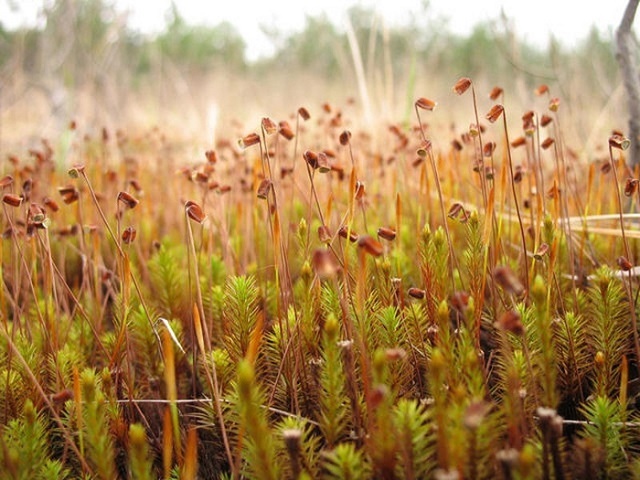
Unlike Sfagnum, Cukushkin Len is recommended to collect in cloudy weather, so it will preserve its qualities. After collecting, this kind of moss is laid for drying into long strips, which, after drying, can be laid on the wints of the logs. It should be remembered that Cukushkin Flax is not dried thoroughly, since it should have a certain percentage of adhesion. If the raw materials are rapidly dry, then it is necessary to moisten it when installing it. However, often Cukushkin Flax is laid even in a freshly collected form.
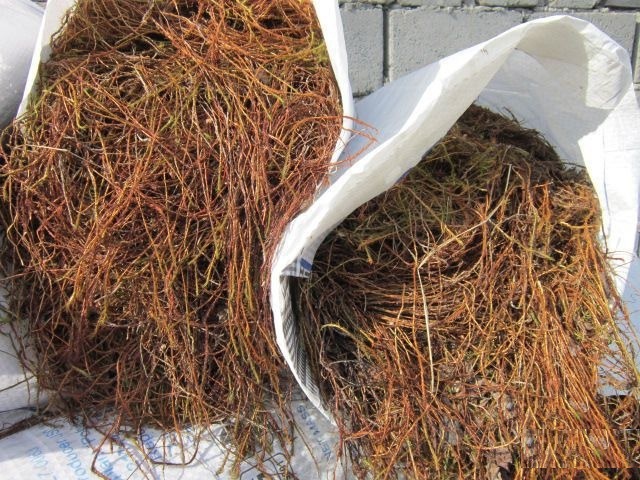
The interventional seal process is carried out in 4 ÷ 5 layers, each of them fit perpendicular to the previous one. When laying on the insulation of the log, the material should be cohored, since this process Tel fucked accuracy. Upon completion of the works of Moss, the remaining hanging outside, you need to legally in the joints of the logs using the chisel.
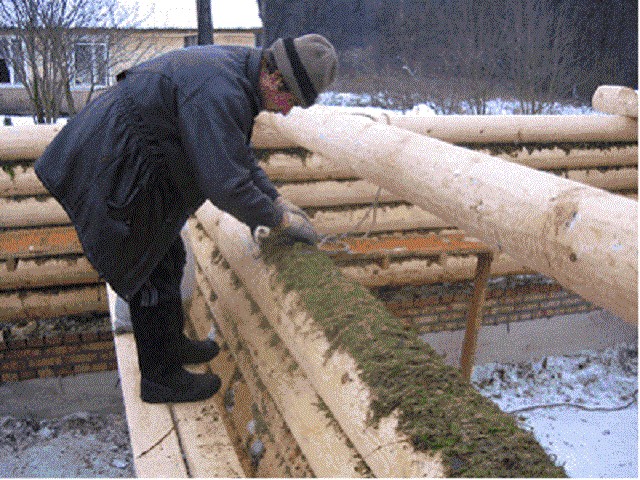
Cukushkin Flax has a good density and does not crumble when dried. It is not susceptible to putrid processes, not afraid of high humidity and retains all its insulating qualities for the entire period of its operation.
This insulation also has its drawbacks, which should be taken into account when choosing it, is low fire resistance, as well as the heterogeneity and the crushing of the material that makes it difficult to lay it. In addition, it is one of the favorite bird feeds. In order to protect the insulation from the feathers, it needs to be well fed into the seams between the logs, and close from above with a jute rope.
Jute insulation
Another effective insulation of interventic junctions is a jute made from a tropical annual plant of a family of linden name with the same name, the fibers of which has an increased percentage of lignin content. So called a unique resin, which is an excellent natural antiseptic capable of protecting not only the insulation itself, but also m.atteryial timber or logs.
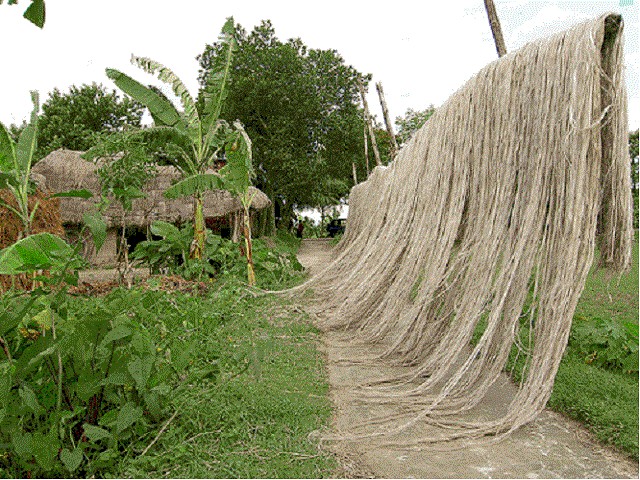
Thanks to this component, the jute material of the racks to moisture, and therefore is not subject to putrid processes. It does not disappear birds and do not damage rodents, which is also very important for the qualitative insulation of the residential structure.
Jute insulation in our time is often produced in the form of a ribbon of 100, 120, 150 and 200 mm wide, a thickness of about 15 mm. The density of the material of such a thickness is 400 ÷ 450 g / m². The insulation tapes are rolled into rolls for 2000 mm.

In addition, the jute makes the ropes, also used for the design of interventic seams of log or bruschers.
Jute has a golden shade, which perfectly harmonizes with the color of the fibers of any breed of wood.
However, paradoxically, his main dignity becomes paradoxical, very often, very often, the oversupply of lignin contributes to gluing its fibers, why the material loses its plasticity, becomes rude and tough. Therefore, the jute is combined with linen fibers, also used for the insulation of the crowns.
So, several combined options are made:
- Linen Jute ( jute Len.);
- Jute Felt.
- Linen jute is made of linen and jute fibers. Their ratio may be different from each individual manufacturer, therefore the characteristics of the insulation are somewhat different.
Ideal are considered to be the ratio 1: 1, since the material obtained is combined in itself the elasticity and softness of flax, as well as the rigidity and strength of the jute. Linen fibers are inside the tape, and the jute acts as a protective layer - as a result, a resistant and plastic insulation is obtained.
Therefore, the combined material is considered an optimal insulation, especially for such problematic objects in matters of high humidity as saunas and Russian baths.
- Jute felt is also made of flax and jute, but in a ratio of 10% to 90%. In this embodiment, two components are mixed with each other. Len dilutes the stiffness of the jute and does not allow it to be glued to its fibers, which favorably affects the insulation and antiseptic quality of the material.
Like any ribbon insulation, jute is simple in laying. The main thing is to choose the proper wint of the width of the tape.
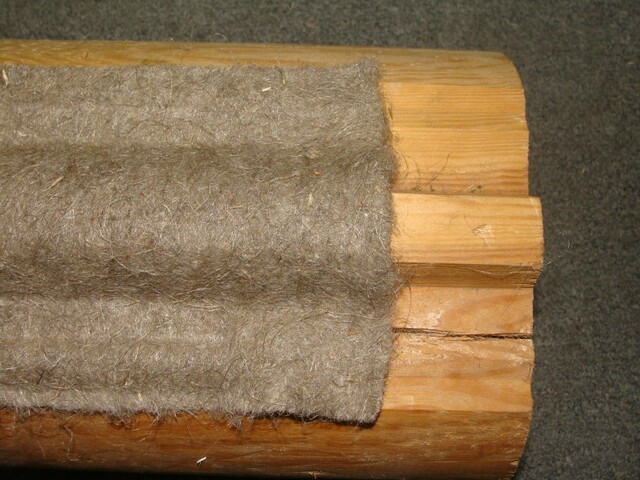
The tape is rolled on the crown, and if skes are formed, they need to be adjusted and attached to the brackets with a stapler. Experts advise you to choose the width of the ribbon a little more than the size of the crown, and when installing make the bend - this process PR jdaist appearance And the required thickening of the insulating layer.
Insulation - Paklya
Pacle is made from different materials - It can be linen or hemp, and consists of recycled fibers of these plants. These fibers are sometimes pressed into tapes, and is also used to insulate the crowns, having good thermal insulating indicators.
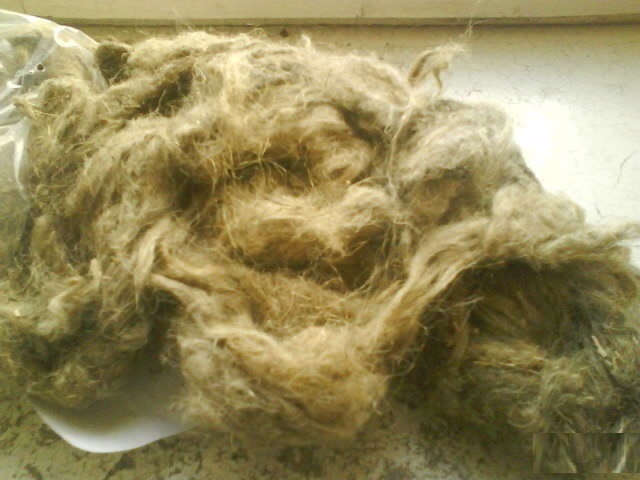
Packle - long known, but, alas, not the best insulation
Despite the good insulating properties and affordable pricePacle did not become so popular for the insulation of the crowns with material. One of the reasons for such unclaimed can be called big love of birds to this insulation. Its fibers are easily separated from the total mass, so the birds willingly enjoy this, building in the spring of the nest.
After such raids, the seams have to repair annually. If this material is used, it is recommended to close it from the outside by the jute rope.
It should be noted that the panel is more hygroscopic than other insulation - it absorbs moisture and is susceptible to rotting. It is advisable to apply indoors with normal humidity, so it is often used to insulate window and door openings If windows and doors are made of wood.
From the foregoing, it can be concluded that any package is not the best choice for the insulation of the crowns.
Sheep wool (felt)
Sheep wool has long been used as insulation, especially in those countries where sheep is developed. Over time, such a insulation began to be made on an industrial scale and exported around the world.

Natural felt from sheep wool - excellent material for the warming of a church
This material is made of purified and treated with insects of raw materials, by mixing and compound into one canvas woolen and felt fibers.
The insulation is made with a thickness of 12 to 18 mm, from 90 to 200 mm wide and has very high thermal insulating and soundproof properties.
- Due to its elastic and spring structure, the insulation fills all the interventory space, without leaving the cold bridges. When shrinking the walls or expanding the gaps between the logs, it is able to shrink and straighten.
- Natural felt do not take place over time and is not compacted, therefore does not lose its initial qualities.
- Sheep wool perfectly accumulate moisture, contributing to good vapor permeability of the seams, so it is not amazed by fungal formations and does not rot.
The only drawback of this material can be considered its high price, as it is mostly represented by only imported samples.
Artificial insulation
For interventory insulation, artificial insulation are offered by manufacturers. Some of them are more or less suitable for this process, it is also worth considering.
« Polyterm "
Manufacturers "Polyterma" characterize it as an environmentally friendly thermal insulating material, as it produces from 100% polyester fiber, its production technology is developed in Finland, where successfully applies in the harsh and surrounding climatic conditions for a long time.
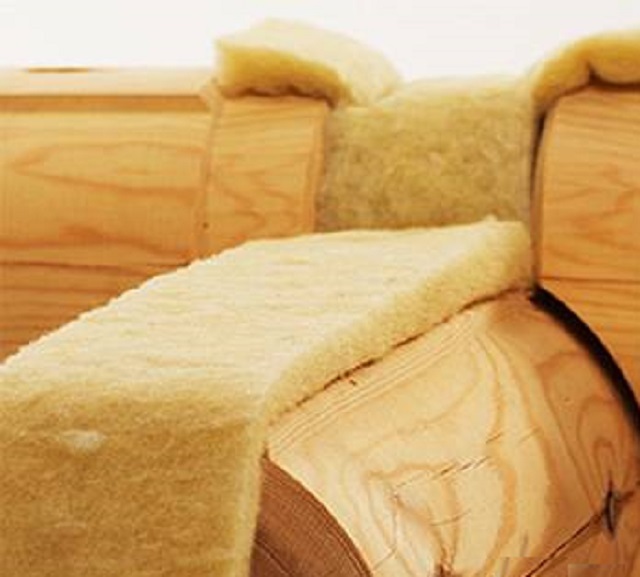
Warming of a chub "Polyterm"
"Polterm" is widely used as an interventory insulation for residential buildings, for saunas and baths.
The positive qualities of the material applies the following:
- This material is "breathable", which means it will be good to harmonize with the structure of the wood. "Polterm" is not hygroscopic and has the ability to push moisture, therefore, using it, you can not worry about additional sealing work.
- The insulation has parry permeable Properties, that is, does not prevent the natural exchange of gases and vapors.
- Thanks to the advantages mentioned, the insulation tape does not arise a favorable environment for microflora development. Unlike natural materials, polyterm is unattractive for birds and various insects.
- The material is elastic and elastic, so during the shrinkage of the walls or drying of the wood, it is painted and fills the resulting space.
- Polyterm has high fire resistance.
- The most important quality is the low coefficient T of the provision.
- The material does not contain harmful phenol formaldehyde compounds.
- The chemical composition of the fibers does not cause allergic reactions in the body.
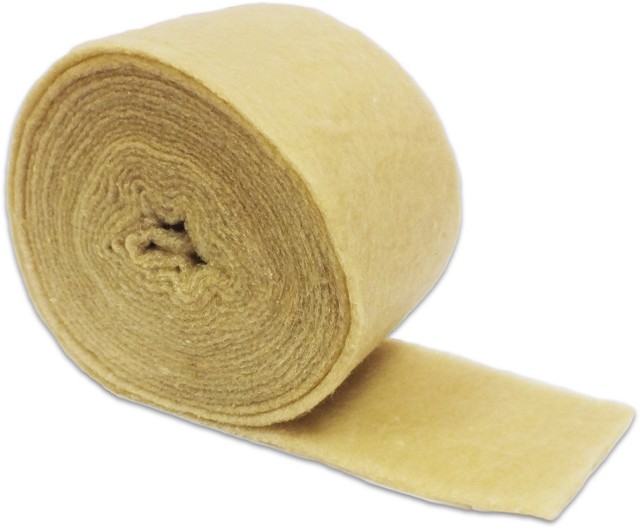
Roll "Polterma"
Manufacturers argue that Polyterm may well not only replace natural materials for interventical insulation, but even fulfill their function at a higher level.
Video: Hollofiber is a representative of synthetic interventic insulation for the house of a bar.
Latex sealant
For the insulation of wooden buildings, sealants made on various bases are also used. One of them is "Consil", which is intended for interventory insulation and sealing natural cracks on logs or a bar arising from the drying of wood.
![]()
Banks and Tubes Latex Sealant "Consil"
"Consil" is a single-component sealant manufactured on a latex basis and used for exterior and internal works associated with the tree.
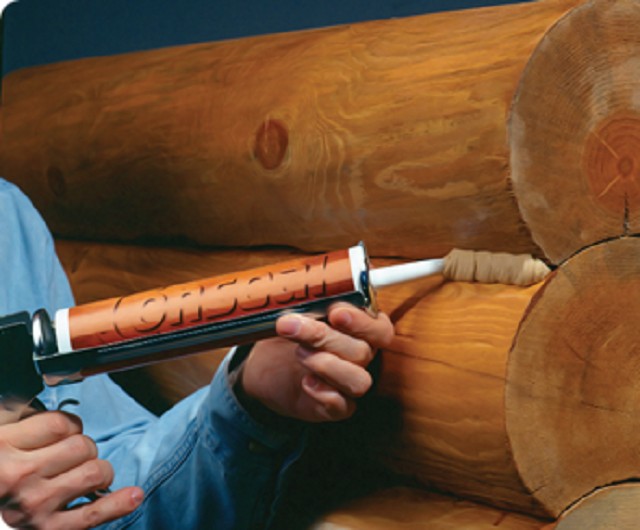
Sealing sealants of the keys of a log cabin, ...
- Latex sealant allows you to normalize moisture and temperature mode, comfortable for living inside the log structure.
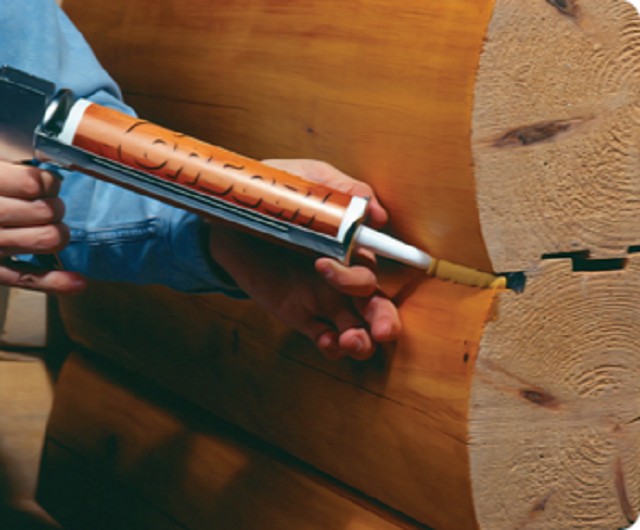
... or grooves in a sruba from a profiled timber
- This material perfectly holds back wind streams, so the walls become not blown, and there will never be drafts in the house.
- Thanks to sealant, there is a completely lack of heat leakage, so it is maintained in the house, which allows you to significantly reduce spending on heating.
- Seams embedded by "Consil" do not require periodic repair - Konopkkawhich periodically have to be carried out if natural belt insulation is used.
- The sealant ensures reliable closure of interventic gaps and cracks from penetrating inside the house of various insects.
- The insulation is made in different colors, so you can always choose the necessary option for a particular wood species.
This looks like a diagram of poorly insulated log cabin. It is shown what problems may occur with wood logs, as well as how serious heat leaks will occur from the room.

Schematic - what causes poor-quality warming of a church
Since poorly embossed interventical gap is not protected from atmospheric influences, the risk of dampness and mold, the appearance of insects, penetration into the wind house and sounds from the outside, as well as cold in winter and hot air in summer.
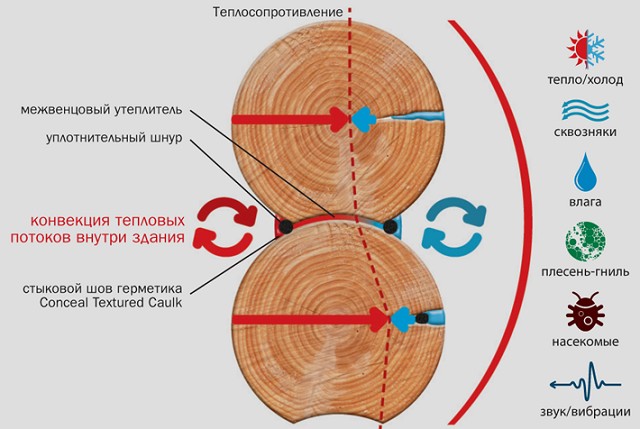
If the interventic gaps and cracks on the logs sealed Reliably, the house can be considered protected from all the mentioned problems. The heat generated by heating devices remains completely inside the house, and the street cold or heat will not have bridges for penetration inside.
Application sealant passes quite simply, as it has aggressive adhesion with wooden surfaces, literally absorbed into them. A good clutch of materials is maintained throughout the construction time of the building, since the "Consil" is not affected by low and high temperatures.
The sealant remains elastic and is able to change the size and form repeatedly, under the influence of expansion and drying wood or shrinkage of walls.
It is impossible not to mention the moisture resistance of this material. After a rejection of ON. not exposed to atmospheric precipitation, does not pass water and is not washed away She from the gaps. In addition, the sealant of racks is not only to the temperature difference, but also to the ultraviolet component of sun rays.
According to the results of the tests conducted on the use of various temperatures, aquatic medium, ultraviolet and deformation by 50%, the manufacturers predicted the operational period of the material - it is 30 years or more.
Nuances laying interventory insulation
Whatever the insulation is chosen for the crowns, its laying occurs in one scheme. Naturally, the ribbon material is fixed much easier than laying moss or pass, but those and other works are carried out according to a single principle.
- The tape insulation is rolled on the surface of the laid log and is fixed with brackets. If the insulation is wider than required, its edges are wrapped and also fixed with brackets.
- If the edges of the insulation were not wrapped inside before laying the next log of it, then after the completion of the work, these excess are clogged into the slots using the chisel. This process is called primary pantry.
- Secondary panting is carried out in a year, after the walls are given shrinkage.
- When used for the insulation of moss or packle, the material is neatly folded on the crown, a layer of 10 ÷ 15 mm, pressing it to the base.
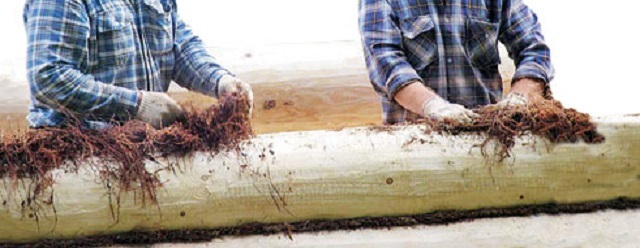
- After laying on top of the insulation of the logs, hanging on the sides of the fiber (usually make the allowance of the PR IMERO, 50 mm in each direction) are also refueling into the gaps between the logs, the same chisel.
- Sometimes insulation is combined by applying a ribbon insulation that is rolled over a bruse or laid into a special groove, and in its edges, the sealing jute cord is placed. After installing the upper log, the gap between the logs from the street is filled with sealant. The gap between the logs on the inside of the wall can be carefully done by one of the natural materials.
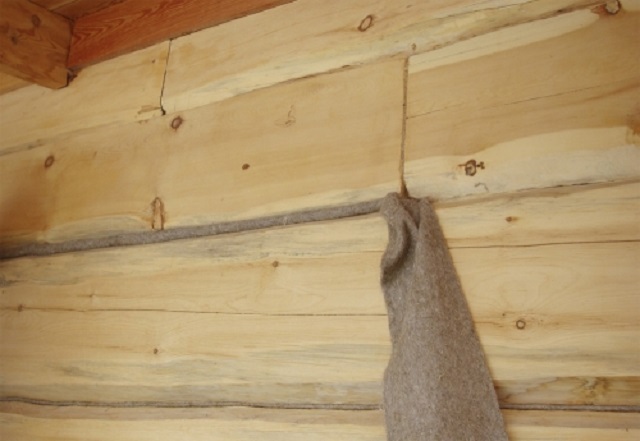
Now, knowing the characteristics of the majority used for the insulation of the crowns of materials, it is possible to study them well, to compare the price level in the region of living or the possibility of independent workpiece, and,
So since ancient times it was necessary that the real Russian bath was built only from the most suitable natural material - wood. Technology training logs or timber, provides for a decrease in heat loss through the walls of the cut. For this make various groove systems.
But, as practice shows that in the conditions of a manual logging, that in the conditions of production, it turns out, it is impossible to achieve an accurate fit of the material to each other. And this means that when you get the bath, warm will go out, to warm it up to optimal temperature Will not be possible.
Therefore, at the initial stage of construction - the construction of a church, each row of logs (crowns) is paired by insulation. It is he who plays the most important role in holding heat inside the steam room.
What are used as an interventory insulation?
It is often necessary to hear that now the choice of them is very big, in truth, they shook these comrades. The most common and in demand, it turns out only three is moss, jute and flax.
Moss
It began to be applied together with the appearance as such, i.e. a long time ago. And over the centuries, he had no alternative. Yes, and in general, it did not arise in this particular need, he perfectly copes with his task to this day.
Moss, being natural, endowed with a number of positive properties.
His advantages:
- Environmental,
- contains antiseptic substances
- Paro - and gas permeal,
- even being under pressure, forms in the interventory layer of the network of aircraft, they hold heat, and also contribute to the breadwinning of the waterproof
- Durable (Cukushkin Len).
Laying on sphagnum
Of course, there are not any kind of moss in construction, but only two are white and red.
Red or Cukushkin Flax meets everywhere and grows sometimes on very limited squares.
Benefits:
- less moisture, than sphagnum,
- easy,
- hard, elastic and durable,
- contains a large amount of substances that prevent rotting, the formation of mold and fungus,
- It is long, facilitated by laying,
- Durable.
From disadvantages, it is possible to note only one thing - it is difficult to prepare in the desired volume.
White moss or sphagnum grows everywhere, it can be found on any small swamp. For most indicators, he is inferior to the Red Moss, but many builders are forced to build a log house on it, because It is much easier to prepare it.
Of course, it is impossible to argue that only negotiatory builders are allowed to stacking logs on sphagnum. In general, he is not bad: it contains these same antiseptic substances, albeit in a slightly smaller quantity, it also perfectly holds heat. The only substantial disadvantage can be called exposure to its destruction over time. But in most cases, it is enough for the average battery life.
As you can see, Cukushkin Len turns out to be preferable to its green relative in many indicators, but the whole trouble is that it does not occur everywhere, so choose sometimes and do not have to come.
You can familiarize yourself with the features of the preparation of Sfagnum in this.
Jute
He is becoming increasingly popular, in cities he almost displaced traditional moss. It is a product obtained by processing annual plant with the same name.
What is it good?
- He, like moss, environmental (if complied production technology),
- perfectly keeps heat (but does not exceed moss),
- It is easy to lay (ribbon),
- saves time when assembling a log house,
- a nice color, similar to natural wood, allows you to successfully fit into the interior of the room,
- Lignin, contained in the fibers, prevents the rotting of the insulation and wood,
- Durable.
We note from the disadvantages: over time, it is glorified, the cost and limited use in logs from logs.
Three varieties of product distinguish: Jute Pakle, Jute Felt and Len-Jute.
- J. Pakla - it turns out with minimal processing of the plant, the fibers are obtained by one-piece and long. This circumstance allows you to use it in the baths of the hand logging, as well as the material for the cavulus of the seams.
- J. Felt - It turns out a deeper processing, it is hard and pronounced. In this regard, a certain amount of flax is added to it, which significantly increases its strength and ensures the uniformity of the jute canvas.
- Len-jute is a mixture of flax and jute fibers approximately in the same proportions (depends on the manufacturer). One other complements, which allows you to get a very high quality and good product, subject to the compliance with the production technology.
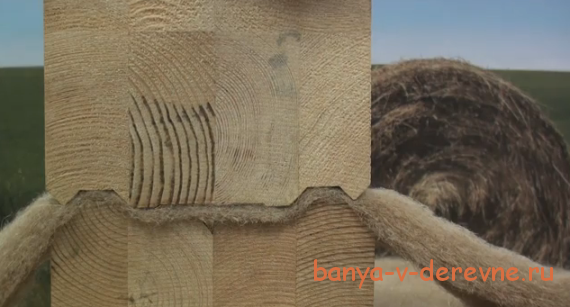
Ribbon insulation
Felt and Len-Jute are produced in the form of a tape, this fact limits its use in ordinary fires, because Uniform in density and even along the entire length material is unable to fill uneven grooves. It is great for baths collected from a rounded log, conventional and profiled bar.
Linen
Luck was used in the old days along with moss. Currently there is a package and a modern product - flanutin.
Linovatin or as it is also called "EUROPEN" Made by modern technologyAs a result, a tape is obtained consisting of the intertwined fibers of this plant.
From the advantages of the product, we note:
- high elasticity and softness,
- durability,
- excellent thermal insulation properties,
- Little hygroscopicity (less than Jute),
- Ecology,
- availability and low cost,
- How any other natural product provides a good microclimate.
Pacle in the form she existed in the last century - in bales, it is probably used for cachatka only.
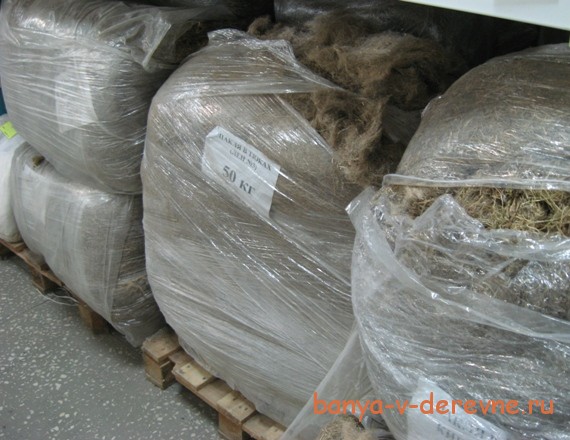
Now they are also made in the form of a tape. The production technology is considered to be the most gentle (normal Česky on machines), the product is obtained more natural.
Not such a dense structure of the material, like the jut-tape allows it to use it in all types of log cabins.
Other insulation
In addition to the above materials, although it is rare, the use of others is practiced:
1) Woolen fiber (very expensive and in the properties ambiguous).
2) Thermal insulating tapes (everything is good - keeps heat, does not let water, does not rot and it is not destroyed, only you can forget about good microclimate).
3) insulation on a mineral or synthetic basis (not for the Russian bath),
4) batting, syntheps, sealants, etc. (see the 3rd point).
If you still decided to build a bath according to the national tradition from, then the insulation choose natural.
Be careful before buying, the material should not contain foreign impurities and feel free to request certificates for products.
After reading the article, many, probably, will not get an unequivocal answer to the question "What insulation is better?"
Allocate only one is really difficult, each has its pros and cons, you can only recommend the following:
- Moss and pack of flax will suit for the cutting cutter
- For docking and bar - moss, Len-Jute, Fliminatin.
Between the crowns refers to outdoor thermal insulation. And it is very relevant for log Bani.Because from the inside such baths are usually not insulated.
The choice of material is not easy: there is a huge number of different means of both natural and artificial origin.
So in search of a response to the question: "What interwidden insulation Better for a bath? " Many spend not little effort and time.
Interwetant insulation for a bath: what to choose?
As already mentioned, you can divide into two large groups:
- Thermal insulated on the basis of natural materials;
- Synthetic insulating materials.
Natural
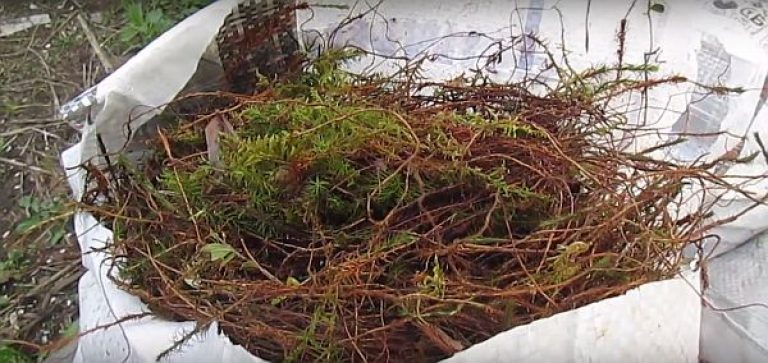
To insulation from among natural vegetable fibers include:
- jute (including jute panel and jute felt);
- linen;
- combined options: Linovatin and Lena;
- moss (as the most traditional insulation for a bantal chub).
Jute
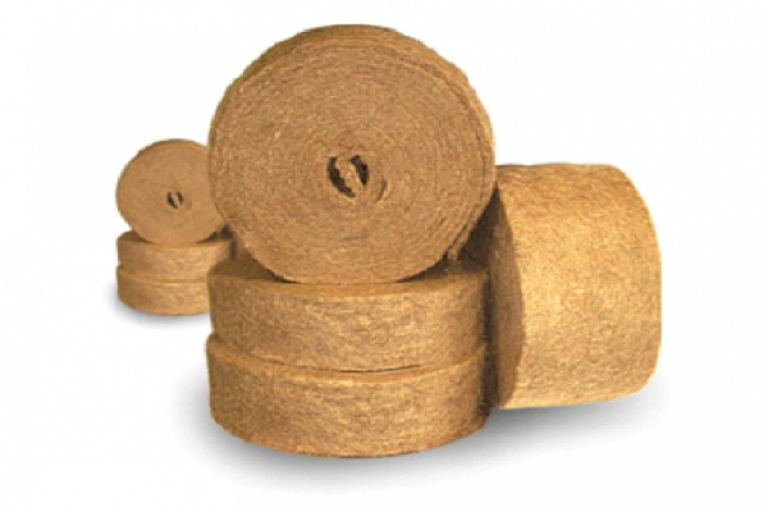
It is a very popular material that is produced in small ribbon rolls. Its thickness ranges from 5 to 15 mm. Differs high density and homogeneity. This is especially manifested after complete laying: jute is even more connected, acquiring resistance to moisture and wind.
It is easy enough in laying, you need to roll the roll to the desired length and secure (for example, a construction stapler).
To minuses It can be attributed sometimes an excessive rudeness of fibers and low stability on the break.
Linen

Len is inferior to the jute in ease of use, but also in demand. It is believed that counted the ability to take and give moisture, it allows the construction of "breathing". It is softer and easier takes the necessary form.
He refers to K. hypoallergenic Substances and has a disinfectant property.
By the wayThe ability to skip water forms some minus flax: from the point of view of moisture and windproof, it is not very reliable. In addition, flax is subject to destruction from moths and other insects.
Combined Options: Linovatin and Line
When choosing combined materials, make an emphasis on the ratio of the number of jute and flax in them. Depending on this, the material will be in more than possess those or other above described pluses and minuses.
But, of course, the combined materials can be called good choiceAs they will be more versatile and remain available to any budget.
Useful video
See what the jute differ from the flanity, according to the expert:
Moss (Red Moss, Sfagnum, Cucushkin Flax)
It is a very common and traditional material that can be prepared independently, or buy at a bar. It has a bactericidal property, but has a large number of minuses.
To negative features include:
- predisposition to drying and spontaneous falling;
- labor intensity of the process of cacopa;
- exposure to the destruction of insects and pull out birds.
Based on sheep wool
 A separate category is a heat insulating material based on sheep wool.
A separate category is a heat insulating material based on sheep wool.
Most often applies when building a bath from a profiled timber. He plays the role of insulation, moisture and windproof. This is possible due to the ability of wool like wood adjust the humidity.
Another incomprehensible plus is its durability: over time, he does not lose its original volume.
To his minuses It is possible to attribute the high cost and the potential danger that in such a heater may start mole.
Synthetic
Synthetic heaters include:
- heat insulating tapes;
- combined materials.
The last two types appeared on the Russian market relatively recently.
Ribbon material attracts what allows you to save time on the installation. This in turn significantly reduces the time required for the construction of a bath. Simultaneously with insulation, ribbons are able to remove moisture and play the role of windproof. They are safe and hypoallergens.
They are presented in a wide range depending on the parameters:
- - density (from 300 to 800 g per square meter);
- - width (from 100 to 200 mm);
- - Quantity (rolls from 10 to 50 p. M).
Attention! The question of their safety when exposed to high temperatures is not fully studied.
Heater for a log cabin or for a bar
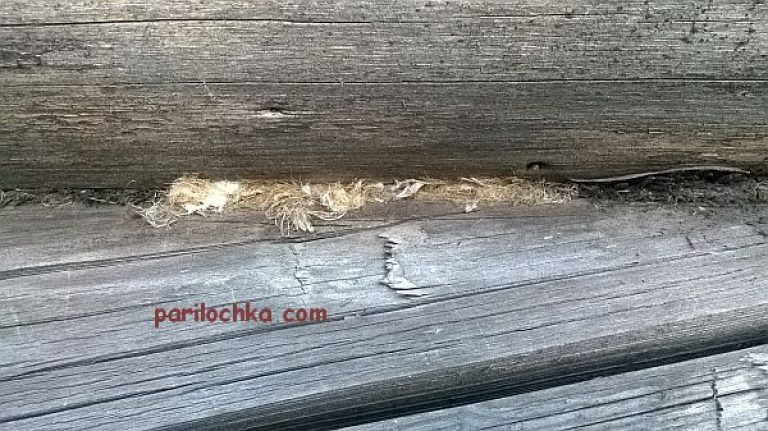
For the log, a thicker layer of insulation is taken (especially a ribbon material), and for a bath of a bar, a thickness of 8-10 mm is sufficient. In the case of the use of glued timber, it is possible to do with a thickness of 5 mm. IMPORTANT! In the presence of gaps or other irregularities of the bar, the insulation is placed in two layers.
For logs, materials based on vegetable fibers are perfectly suitable, and for a bar - rolled products.
Warming Baths from a bar preferably complete finishing materials: Encourage clapboard, siding or block house. Wood finish materials We advise treated with special impregnation or oils.
Useful video
Look at the opinion of a professional on the issue of "Moss or Jute":
Vegetable fibers or ribbon material
Vegetable fibers are most often more accessible by the cost criterion, but they require more time on the laying.
Vegetable fibers have greater environmentally friendly, but have a smaller service life compared to synthetic materials.
Summarize: what kind of interventic insulation is better for a bath
As you can see, the question about the interventic insulation for a bath, which choose, requires a personal decision. We gave you information to reflect. The choice of interventory insulation for the bath should lay on the basis of individual needs, as well as preferences and real capabilities (financial and temporary).
In contact with
Frequently, a bath from a log was insulated exclusively with a pantry - when natural material was pushed between the logs manually. And this method has, of course, its undoubted advantages. But the disadvantages are not happy: not enough that all work on the pantry is quite laborious, it requires special skills and goes far from one stage, so also the caperpath itself for many bunchings to pull the birds. From what experienced builders It is recommended to see such a bath of expensive siding to see such a bath - but why did she even build it from an environmentally friendly beautiful log? But, fortunately, today there are other types of interventional insulation - no less eco-friendly, even more practical and completely excluding. And what modern interventic insulation is better to help decide this article.
Interwette insulation: how to choose? What is the better interventor insulation for a bath? It is impossible to answer these questions unambiguously - each has its own pros and cons, and some advantages.
Membling Head Wool Insulation
A good interventic insulation for a profiled timber - from sheep wool. For insulation wooden bath He is just perfect - the truth is not enough. But absolutely does not fit and in terms of its qualities, it is significantly superior to all modern belt insulation.
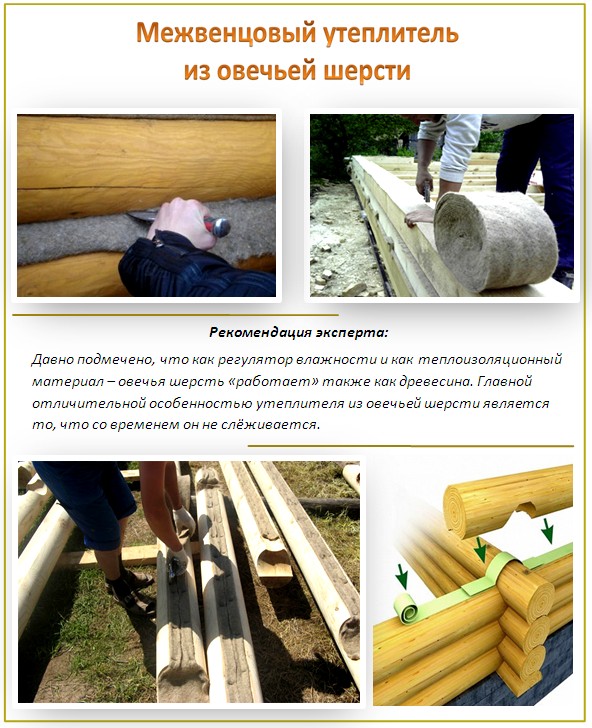
Tape interventian insulation
This insulation is quite new for russian marketHowever, it has already managed to conquer its popularity. His main advantages are that in general, the whole building assembly occurs quickly, labor costs are reduced, and the insulation itself does not accumulate moisture, is not blown, hypoallergenically and completely not attractive for birds. High-quality belt insulation gluits after laying walls.
It is interesting for its composition: natural fibers break through special needles with hooks-jar, and, intertwining among themselves, these fibers form a sufficiently dense substance, which in its structure resembles felt. His standard dimensions Such: Length - 10-50 Ramating meter, width - 100/125/150/200 mm, and thickness varies from 5 to 15 mm. Different with this insulation and surface density - 300-800 g \\ sq. M.
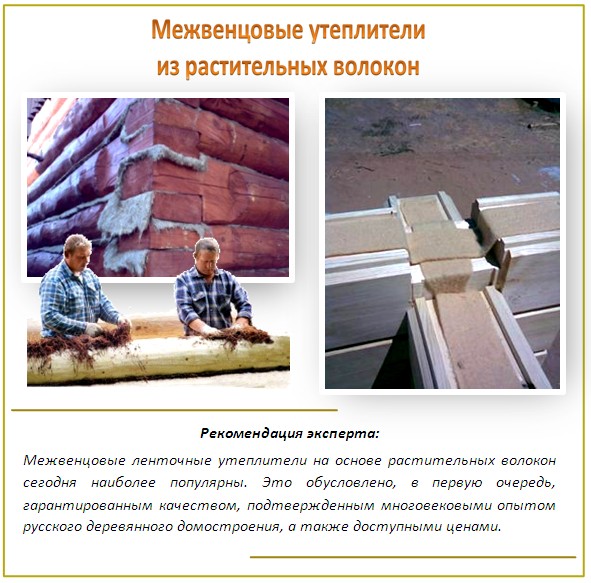
But the most important thing is to determine the thickness of the tape insulation, because It must be selected depending on the cut thickness. So, for chopped wood, a heater is needed 15 mm thick, for a conventional timber - 8-10 mm, and for glued - 5 mm.
There are also its features of such a insulation. So, if the bar is uneven, put better tape in two layers.
The same belt insulation today is made from flax or jute, or in the combined version - the flanutin, the percentage of the ratio of materials in which may be different are. What their quality and scope depend on.
A popular jute interventic insulation today is considered an excellent alternative to expensive pant. It represents a ribbon with a thickness of 5/10/15 mm, a sufficiently dense and homogeneous. It is necessary to roll it right in the groove, fixing in the course of a construction stapler. And after laying a cut, Jute condenses even stronger - its fibers glue and acquire enviable resistance to wind and moisture.
Walls with this insulation are beautiful, with perfect seams, warm and not needing in any other finish. And the jute fiber, in contrast to flax, uniform thickness and easily spread over the crowns.
Interwidden linen insulation
Although this stake has its advantages. For example, he quickly absorbs and quickly gives moisture, and the walls really "breathe". Flax is not allergic and not dangerous to health, does not create a static charge and well prevents the appearance of fungus on the walls. In addition, if the interventic insulation for a bar is precisely from flax, no other ventilation the bath is not necessary. And the most important thing is that such a heater does not have intersection, and therefore harnesses can be made by hands of any length and shape.
And finally, more environmentally friendly material for the insulation of the walls do not invent - even linen clothing is considered healing.
Combined Heattels: Mezernantic Heater Linovatin
As for the combined options, the larger in the tape insulation of the jute, the way it is less powerful. Indeed, this plant contains a special polymer of lignin, which fastenses in the wood the very fibers of cellulose. But in the Lena of this substance is only 2%, and therefore it is more susceptible to moisture. In addition, the more flax in the insulation, the more likely that it will eat it, but the jute pest does not like. And jute is blowing much less flax.
How to find out that in the interventory insulation there are no additions of flax? Easy - in color. It must be golden, i.e. Light brown, but gray splasions say that Lena was added to it.
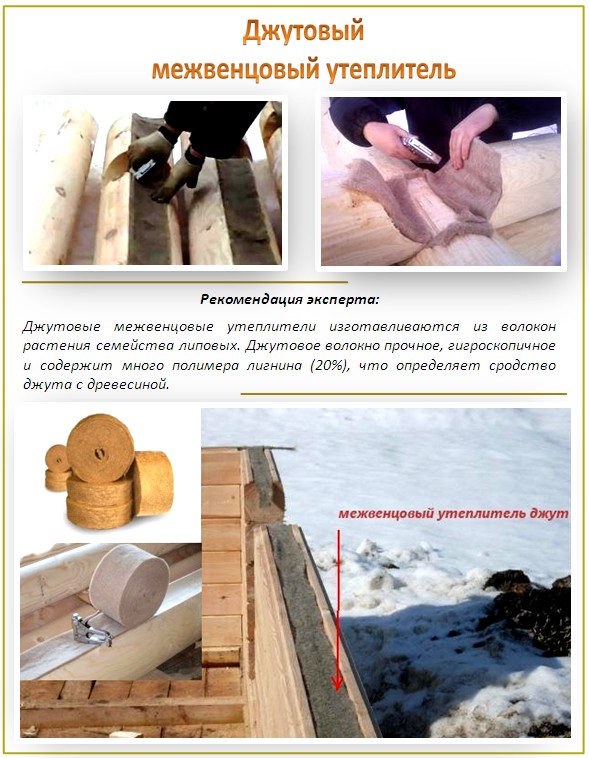
Wooden house-building is popular with individual developers. The construction technology of houses from glued bar provides for the use of an interventional insulation from jute, which is inherent in improved operational characteristics. The main purpose of the material of plant origin is the insulation of the crowns of the brusade or log construction - it is a reliable protection of wood from premature aging and deformations. It also contributes to an increase in the life of wooden buildings.
This is a special sealing tape that has the same width as the stacked grooves of a log material. Ribbons are produced different widths: ranging from 30 mm, and each step of magnification is 5 mm. Maximum width - 260 mm. Thanks to a wide variety of sizes, the seal is easy to select for any building material: glued bar, rounded or profiled log. The thickness of the seal varies from 7 to 15 mm. The insulation of inter-winter (jute) in rolls of different lengths is sold - standard dimensions range from 10 to 50 rose meters.
 A jute insulation of vegetable material (100%), the so-called spinning culture, which refers to the linden family is manufactured. The strength of jute threads is equal to hemp counterparts, but their composition contains almost the same amount of lignin, as in coniferous trees: in jute - 20%, in pine and ate - from 24 to 28%. It is this property mainly affected the scope of application. natural material.
A jute insulation of vegetable material (100%), the so-called spinning culture, which refers to the linden family is manufactured. The strength of jute threads is equal to hemp counterparts, but their composition contains almost the same amount of lignin, as in coniferous trees: in jute - 20%, in pine and ate - from 24 to 28%. It is this property mainly affected the scope of application. natural material.
Due to the presence of lignin, which is a high-molecular natural polymer, an interventic insulation from jute has unique fastening properties and is equivalent to concrete. Vegetable fibers have a reliable clutch between themselves, but their bonding occurs only after laying and under the pressure of the bar.
Applying the plant seal, no additional decoration of the indoor room is required, which significantly reduces the cost of building a house.
Main features and characteristics
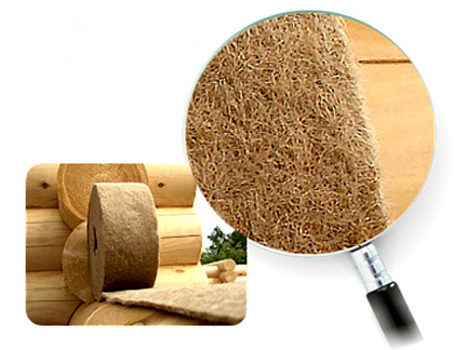 The genuine sealing tape for glued bar differs from other analogues (packles, moss, flax) with its unique properties:
The genuine sealing tape for glued bar differs from other analogues (packles, moss, flax) with its unique properties:
- high resistance to atmospheric influences (wind, sun, moisture);
- waterproof;
- strength and monolithium that material acquires during operation;
- good heat and sound insulation;
- ecology and safety - there are no chemical impurities in composition, vegetable material is not toxic;
- biological purity - as a result of special processing of jute threads, all pests and microorganisms die.
When using natural material, a wooden building acquires a neat appearance and differs with high features of aesthetic. The color of vegetable fibers beige-golden, so it is as close as possible to natural shades of wood and is harmoniously combined with a log or a timber.
The interventic insulation belt is indispensable in wooden housekeeping and does not need additional processing, so it can be used for laying in a log cabin immediately after purchase. The smooth ribbon rolls over the entire length and is evenly laid between the crowns, and then, the next row of timber is stacked. Such technology is featured convenience and simplicity, does not require much time. But if irregularities and defects are present on the wood surface, then the tape of greater thickness should be used.
Vegetable fibers under the weight of the glued timber (log) are so much so that there are no slighted cracks between them.
The jute seal has a long service life (at least 75 years), and the dense base is not amenable to rotting and stratification throughout the entire period of operation. Another advantage is the availability of material - the price of vegetable thermal insulator is low, which significantly reduces the cost of construction.
Varieties
In the domestic market presented different types Sealer:
- jute felt;
- jute;
- superjut.
Purpose
The Jute insulation is ideal for wooden buildings of various purposes - these are residential buildings, baths and saunas. Thanks to the universal compactor from Jute accelerates construction works. Full filling of space between the crowns ensures reliable and high-quality insulation breeding walls. Of all the materials presented in the construction market, this is the best heat-insulating material that is used for the cacopa of the walls from the bar in residential and non-residential buildings. 
Despite the dense base, the air joined the air well, so the sealing material "breathes" and regardless of the season (summer or winter) inside such a house is created by a microclimate human body. Laying the interventory insulation from jute fibers is performed in one layer. But when irregularities are present in the bar, then the layers can be two or more.
Jute Meshventsova is used to insulate the walls in houses from glued and profiled timber, as well as in log houses with walls of natural humidity.
Criteria of choice and what to pay attention to when buying
By purchasing a jute insulation, the main thing is not to be mistaken in its quality, which primarily depends on the purpose of the material. When choosing an interventory insulation for glued timber, you should definitely pay attention to:
- Ribbon width. Recommended parameters should not exceed more than half of the diameter of the log.
- Density. In cold buildings, less dense varieties of material can be used (up to 400 g / m2), therefore this indicator It is not so critical when buying an interventional insulation for a bar. What to choose a material when erecting a log house? In this case, it is not necessary to save on density, the optimal indicator should not be below 600 g / m2 with a tape thickness of 8-10 mm. Such walls will have high heat and sound insulation properties, as a result of which the costs of heating will be reduced, and the building itself will last for a very long time.
- Color and lack of additives.The interwetant insulation of Jute has a golden brown tint. If the surfaces of gray or dark color are noticeably released on the surface, then this indicates the presence of recycled flax waste, jute mischoles or woolen fibers. This material consists of not natural fiber and has lower technical characteristics, Therefore, it is better not to use during the construction of a residential building.
- Heterogeneity and presence of seals. High-quality material has a dense uniform texture and a smooth surface, if this is not observed and there are seals, it is a fake.
- Cost.The low price of the jute insulation is the main indicator of poor quality, so such a seal can be used only in non-residential buildings.
Before buying an interventory insulation for a bar, in addition to visual inspection, it is advisable to get acquainted with the compositions of the material, so you need to ask the seller a certificate. If you have additives, it is better to give up the purchase of such a material.
The correctly selected material will not only facilitate the work of the builders, but will ensure reliable protection of a wooden building. Knowing about all the features of the jute tape, you can independently purchase an interventic insulation for a bar, which to choose - completely depends on the appointment and application area.
What should be the interventic sealer for the bath
Despite the fact that wooden buildings are erected with a different goal, the technology remains almost unchanged, only there are some nuances. The laying technique involves the use of interventional insulation for a bath. Which thickness to choose a tape from jute depends on the quality building material For walls. If the surface of the bar is smooth, then the tape is up to 7 mm thick. The more defects and irregularities, the thicker should be a jute seal or laying is performed in two layers.
Create a heater for a bath from a log cabin is cheap, which will allow to save on materials. Ideally, for such buildings, it is better to use an interventic insulation from jute at a low price.
Laying options and fastening method
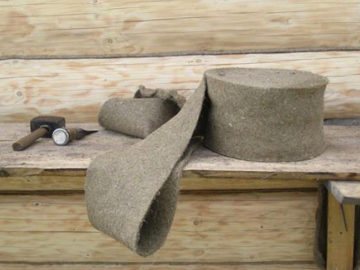 There are several methods for laying a jute insulation:
There are several methods for laying a jute insulation:
- in one layer;
- folding twice;
- fold inside a log (indent from the edge from two sides to 5 mm).
When assembling the house of glued timber, it is necessary to correctly pick up the width of the tape. Mounting to the seal bruse is carried out using a stapler. But for the mounting can be used and drill - the fibers of the insulation do not cling to the drill in the process of drilling.
Important! When assembling a brusade house with changing grooves, the width of the vegetable sealer is required for all working length.
The cost of the insulation of the interventovation in different cities of Russia
The cost of the jute sealing material directly affects the thickness and width of the tape. The table indicates approximate prices for the insulation, which is implemented in different Russian cities:
Production of the jute sealer for a log
Today, Russian manufacturers offer interventic insulation from jute in a wide range. Therefore, from a huge variety of laying material, you can always choose the best option that will meet the proper quality and technical requirements concrete structure. The advantage of environmentally friendly and practical laying material is the available cost.
The main producers of vegetable insulation in Russia are the following companies:
- LLC EKOSERVIS
- LLC "Center Eco Insulation" - trademark Polterm.




